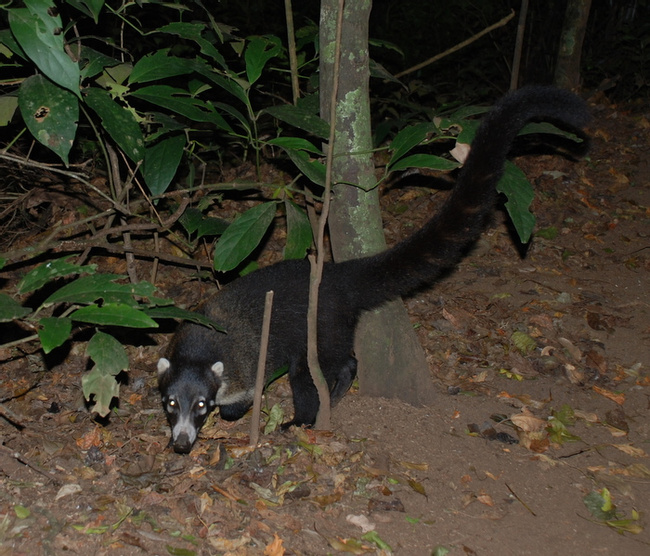
More about Coati
Habitat
Within its range, the coati can survive in any wooded habitat at elevations of up to 3,000 m. The coati lives in a range of forests, from temperate oak and pine forests to deciduous and lowland tropical rain forests. It is even sometimes seen in deserts and savannas.
Range
Southwestern Arizona through Panama and Columbia to Argentina.
Physical Description
This mammal is distinct with its long mobile snout and faintly ringed tail which is nearly as long as the rest of its body and often carried erect. The body is colored pale to dark brown or reddish or yellowish and the tail banded yellow and brown, with white snout tip and shoulders. Its eyes are ringed with a reddish or brown mask, similar in pattern to the raccoon. Coloration of an individual may change from molt to molt, regardless of sex or age.
Biology and Natural History
The coati is the most diurnal and social member of the raccoon family. It is also impressively flexible and opportunistic in its behavior, and widely adaptive in its geographic range and repertoire of viable habitats.
Comfortable and agile in the tree tops as well as on the ground, the coati uses large, strong claws to access different levels of forest. Impressively acrobatic, it can climb down trees headfirst, pass from tree to tree on small branches high off the ground, and even walk upside down hanging from lianas. Its tail is not prehensile but helps balance during climbing. Coatis sleep in trees at night, unless they are hunted in their area by humans, in which case they become more nocturnal.
Coati social structure changes throughout the year. Several family units of females and their offspring collect in bands of 4-30 coatis. Males under the age of two years may also be in the band. Adult males are solitary except during the breeding season, when a single male will join a band of females and occupy a subordinate position for the entire breeding season. They mate in trees or on the ground. A few days before the young are born, the pregnant females separate from the group individually and build nests in trees. The newborns stay there 5 weeks, while the mother tends to them and forages solitarily. Once they are able to keep up with the adults, they come down from the nest and the band regroups. Band members may groom each other, but they also compete for food.
Adult coatis have few predators (aside from humans), but young ones are targets for boas, raptors, cats, and tayras.
Diet
The coati diet is richly omnivorous and opportunistic, comprised of whatever fruits and prey are available in their area, and adjusting with season. They may sniff out invertebrates under the forest litter like insects, spiders, millipedes, or snails, or catch lizards, mice, or other vertebrates of similar size. They also eat fruit when it is abundant. They can use their strong front claws to destroy rotten logs and stumps looking for food, and pursue lizards and tarantulas from burrows that may be up to 1 m deep.
Height/Weight
Adult males generally weigh 6 kg, and are 1.1 to 1.2 m long with a tail 0.500 to 0.6 m long; females are smaller.
Taxonomy
Order: Carnivora
Family: Procyonidae
Sources
Eisenberg, John. Mammals of the Neotropics, Vol. 1. The University of Chicago Press: Chicago, 1989.
Kaufmann, J. H. in Janzen, Daniel H. Costa Rican Natural History. Chicago: University of Chicago Press, 1983.
Wilson, D. E. in Janzen, Daniel H. Costa Rican Natural History. Chicago: University of Chicago Press, 1983.
-Amy Strieter, Wildlife Writer
Coati Sightings
Similar Profiles
We believe travel is more than ticking destinations off a list – it’s about discovering new places deeply, feeling connected wherever you go, and knowing you have a trusted team behind you every step of the way.



